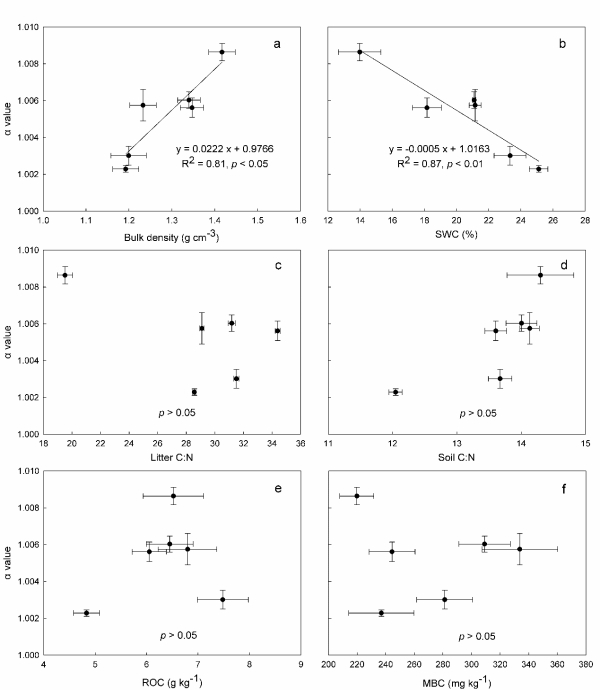

As over half of the world’s tropical forests are reforested or afforested, understanding the resilience of carbon (C) pool in these forests is critical for global C balance. Studies regarding the influence of afforestation on soil C stocks have been conducted extensively in recent years. However, how forest restoration affects soil C turnover is still not well understood, and this may have important implications for long-term soil C sequestration in these restored forests.
To address this question, the Ph.D. student XIONG Xin, under the joint guidance of Prof. ZHANG Deqiang and DENG Qi from South China Botanical Garden of Chinese Academy of Sciences, conducted a field study in south China to evaluate soil C turnover rate with the proxies of α and β that were derived from the correlations between 13C natural abundances and log-transferred C concentrations along 0-30 cm soil profiles in a 400-year-old monsoon evergreen broad-leaved forest, a 51-year-old mixed-native plantation, a 31-year-old mixed-native plantation, a 31-year-old Acacia mangium plantation, a 31-year-old mixed-conifer plantation, and a 31-year-old secondary forest with natural restoration.
Results showed that soil C stock (0-30 cm) can be restored to the level of undisturbed old-growth forests within 31 years after reforestation on degraded land, but the turnover rate of soil C was still significantly higher than that of old-growth forests, regardless of tree species and restoration strategy. The turnover rate of soil C was not significantly different among artificial secondary forests with different tree species but the same age, whereas it was significantly lower than that of natural secondary forests with the same age. In addition, changes of soil C turnover rate among the six forests were mainly regulated by soil water content and bulk density.
This study demonstrates that forest restoration could enhance soil C stock equivalent to the undisturbed old-growth forests within a few decades, but the rate of soil C turnover in these restored forests were still higher. Tree species is not the main limiting factor for soil carbon storage and turnover following forest restoration. Relative to natural secondary succession, artificial restoration management may be more beneficial to recover soil carbon sequestration capacity of degraded land. The findings would be useful for our understanding of soil C dynamics following forest restoration in south China and for sustainable development of these restored forest ecosystems.
This research entitled by "Soil organic carbon turnover following forest restoration in south China: Evidence from stable carbon isotopes" was published in the Forest Ecology and Management. For further reading, please refer to: https://doi.org/10.1016/j.foreco.2020.117988.

Figure. Relationships between the α value and soil properties.

